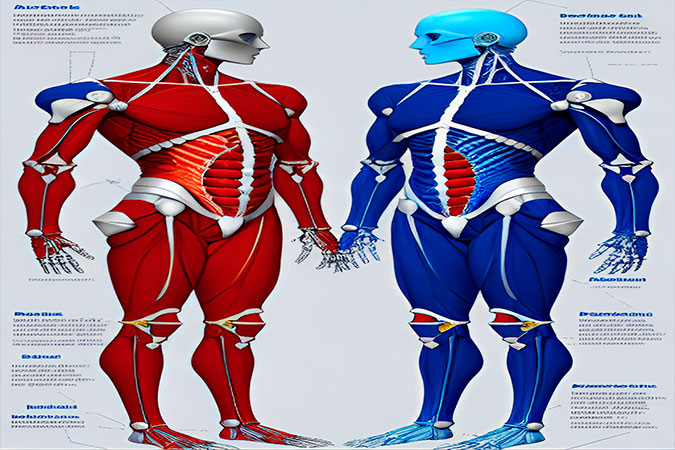Anatomy and Functionality of Synovial Joints: A Look at Shape and Movement
This article offers an in-depth exploration of synovial joints, primarily focusing on their classification based on the shape of their articular surfaces and the type of movement they enable. It provides a detailed examination of seven types of synovial joints: plane, hinge, pivot, bicondylar, condylar, saddle, and ball and socket. Furthermore, the article discusses how these joints are also categorized as uniaxial, biaxial, or multiaxial, depending on the number of planes or axes they facilitate movement in. By illustrating these distinctions, the article contributes to a comprehensive understanding of the complexity and versatility of human movement.

Synovial Joint
Synovial joints, the most common and freely movable type of joints in the human body, are hallmarks of our skeletal system’s versatility and adaptability. These structures are categorized based on two fundamental characteristics: the shape of their articular surfaces and the nature of the movement they facilitate. This article will dissect the different types of synovial joints through these two lenses, providing a comprehensive understanding of their functional variations.
Classification Based on Articular Surface Shape
Synovial joints can be categorized into seven types based on the shape of their articulating surfaces:
Plane (Flat) Joints
In plane joints, the articulating surfaces are essentially flat, allowing only gliding or sliding movements. Examples of plane joints include the intercarpal and intertarsal joints of the wrist and foot, respectively.
Hinge Joints
These joints resemble the hinge of a door, permitting movement primarily in one direction or plane (flexion and extension). Examples include the elbow and the interphalangeal joints in the fingers and toes.
Pivot Joints
Pivot joints allow for rotational movement around a single axis. An example is the joint between the first and second cervical vertebrae (the atlas and axis), which enables the head’s “no” motion.
Bicondylar Joints
In these joints, two rounded areas (condyles) on one bone fit into two concave areas on another. These joints allow for movements in two directions. The knee joint is an example of a bicondylar joint.
Condylar (Ellipsoid) Joints
These joints, also known as ellipsoidal joints, involve an oval-shaped end of one bone fitting into a similarly oval-shaped hollow of another bone. This design allows for flexion, extension, abduction, adduction, and circumduction but prevents rotation. An example is the joint between the radius and the carpal bones of the wrist.
Saddle Joints
Saddle joints, so named because the ends of each bone resemble a saddle, permit a wide range of movements. The most notable example is the thumb joint (between the trapezium and the metacarpal), which allows the thumb its unique opposability.
Ball and Socket Joints
These joints, where a ball-shaped surface of one rounded bone fits into a cup-like depression of another, allow for the widest range of motion: flexion, extension, abduction, adduction, rotation, and circumduction. The hip and shoulder joints are examples of this type.
01
Types of Synovial Joints

Classification Based on Movement
Synovial joints are also classified based on the number of axes of rotation they allow:
Uniaxial Joints
Uniaxial joints permit movement in one plane or axis. Hinge and pivot joints fall under this category.
Biaxial Joints
Biaxial joints allow movement in two planes or axes. The movements at these joints include flexion, extension, abduction, and adduction. Examples include condylar and saddle joints.
Multiaxial Joints
Multiaxial joints, as the name implies, allow movement in multiple planes or axes. Ball and socket joints are the prime example of multiaxial joints.
In summary, understanding the classification of synovial joints based on their articular surface shape and the nature of their movement is fundamental to comprehending human movement’s intricacies. This knowledge is not only important for healthcare professionals such as physiotherapists and orthopedic surgeons but also beneficial for anyone keen on understanding the human body’s mechanics.











